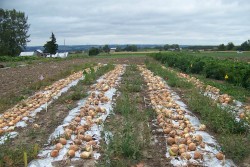Stop the Rot! - Using Cultural Practices to Manage Bacterial Diseases of Onion
Christy Hoepting, Extension Vegetable Specialist
Cornell Vegetable Program

Do you know how easy this is? A simple modification to adjust your planting configuration is all it would take to drastically reduce losses from bacterial bulb decay. Our studies showed that when plant spacing was reduced from 6 or 8 inches to 4 inches with 3 or 4 rows per 3-foot plastic mulch bed (row spacing: 4 rows = 6 inch; 3 rows = 8 inch), this provided 53 to 64% control of bacterial bulb decay at harvest (Table 1). Marketable yield also increased by 1.4 to 2.4 times, representing an increased net economic return of $43 to $258 per 100 feet of bed, due to increased weight of marketable jumbo-sized bulbs (Table 1). We learned that wide plant spacing produces big bushy plants with more leaves, thicker necks, delayed maturity and bigger bulbs. Unfortunately, it was these bigger bulbs that rotted! By narrowing plant spacing, we got fewer colossal-sized bulbs, which we more than made up for by having significantly more healthy jumbo-sized bulbs to market (Table 1).
Alternatives to black plastic reduced bacterial bulb decay by 59 to 75%
This is also a very simple and easy modification for small-scale growers producing onions on plastic mulch to make to their cultural practices that could go a very long way towards reducing bacterial bulb decay. Our studies showed that reflective silver mulch, biodegradable black plastic and bare ground had significantly 1.8 to 2.8 times higher marketable yield than black plastic (Table 2). Reflective silver and biodegradable black plastics had significantly 3.7 and 3.6 times, respectively, higher jumbo weight than black plastic, which resulted in an increased net return of $96 to $215 per 100 feet of bed compared to black plastic (Table 2). All of the alternatives to black plastic had significantly lower soil temperatures compared to the black plastic; we suspect that the higher temperatures of the black plastic are more favorable for development of bacterial diseases.
Stop the Rot article (pdf; 1356KB)

Upcoming Events
2026 Winter Cut Flower Webinar Series
January 6, 2026
The fifth annual CCE Cut Flower Webinar Series begins on January 6, 2026 and continues over 5 weeks on Tuesdays. This is a very popular series of online events you won't want to miss, with topflight speakers, a wide variety of subjects concerning growing cut flowers and plenty of interaction between speakers and attendees.
Tuesdays 1pm-3pm January 6, 2026 - February 3, 2026 (The webinar held on February 3 will run 1pm-4pm)
Cost: $60.00 for all five sessions, $20 for single sessions
Webinars will be recorded, and all the recordings will be sent to registrants for future review.
Expanding Farm Sales: Markets, Profits, and Branding Series
January 10, 2026
Looking to diversify where you sell your farm products? This four-part workshop series helps farmers explore new opportunities in direct-to-consumer, wholesale, and institutional markets. Learn how to meet buyer expectations, price for profitability, and build lasting relationships that support your business goals. Participants will strengthen marketing and communication skills, evaluate which sales channels best fit their farm, and connect with buyers, distributors, and local partners who can help expand their reach. Whether you're just starting out or ready to grow your market presence, this program will help you chart the right path for your farm's future.
Four Session Series: Saturdays from 10AM to Noon, January 10-January 31, 2026
Attend at one of three locations: Schoharie Extension Center - Cobleskill, NY; Otsego Education Center - Cooperstown, NY; Via Zoom
Pre-registration is requested! Fee: $25 Register Here
Any questions can be directed to Kelley Doolin at kmd322@cornell.edu
Pesticide Applicator Certification Exam Prep Course
January 13 - January 14, 2026
Join ENYCHP specialists for an in-depth review of topics covered on the NYS DEC pesticide applicator certification exam. This two-day virtual course includes explanation of key concepts on the core exam, test-taking tips for the core and category exam, practice questions, and Q&A with instructors. Course materials, including program recordings, practice exams, and DEC materials will be available to registrants after the program. This training is geared toward certification categories 1A (agricultural plant), 21 (field and forage), 22 (fruit), and 23 (vegetable).












































